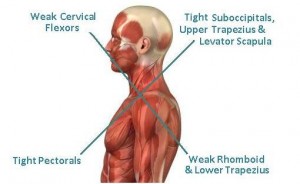Neck pain is a common issue that refers people to our office. Well, neck pain is a condition that chiropractors can help with but a question we get often is “Why do I have neck pain? Pain in the neck can come from different injuries or from our hobbies, jobs and daily lives. Posture and body position is very important. A common postural problem that can occur is upper cross syndrome and it is very common today with our lifestyles of sitting desk jobs, computers and our cell phones. Our last blog discussed the lower body equivalent, lower cross syndrome, so today, we are going to go over upper cross (crossed) syndrome.
What is Upper Crossed Syndrome?
I t is a muscle imbalance in the flexor and extensor muscles of the chest and upper back. Those with a sedentary lifestyle are most at risk but it can be seen in athletic population also, especially swimmers and weight lifters.
t is a muscle imbalance in the flexor and extensor muscles of the chest and upper back. Those with a sedentary lifestyle are most at risk but it can be seen in athletic population also, especially swimmers and weight lifters.
The common changes associated with upper cross syndrome include:
- Anterior head carriage- head moves forward and puts more pressure and weight on the neck
- Rounded shoulders due to tightness in pectoralis and upper trapezius muscle
- Weakness in rhomboids, middle and lower trapezius and deep neck flexors
- A hump in the cervical thoracic region- dowager hump
The effects of this condition can lead to shortening of muscle, decrease of freedom of shoulder movement and decrease of athletic performance. Long term muscle shortening can lead to joint and disc degeneration.
What can you do about it?
First, when experiencing pain, seek professional medical experience if you have the pain for more than a few days. A medical professional like us, a chiropractor, looks for posture and muscle imbalances along with joint misalignment and ways to correct them. The best treatment options include chiropractic adjustments, soft tissue therapy and exercises. Adjustments of the cervical and thoracic spine along with extremities help to stabilize the spine and can stretch shortened muscle. There are also corrective posture exercises, strengthening exercises, and stretching techniques that can be used to help to help stabilize and correct the upper cross syndrome. On a side note, there are different shoulder kinesio-tapings with Rocktape that be done to help muscle imbalances.
A few simple things you can do on your own include the following:
- Tucking your chin to your chest like you are holding a tennis ball under your chin. Then roll and pull your shoulders back and hold this position for 30 seconds.
- Pectoralis minor stretch- Stand in a doorway, lined up with the opening. Place your arm at shoulder height in the doorway at right angles as shown. Place one foot in front and one behind for stability. Keep your spine straight and rotate your body downward, “nose-dive” fashion. Note: don’t push through the doorway, rotate downward. You should feel a stretch in your pec area.

Give us a call today if you have any questions or need some help. Our doctors are great with these types of issues. (402) 261-5766.

